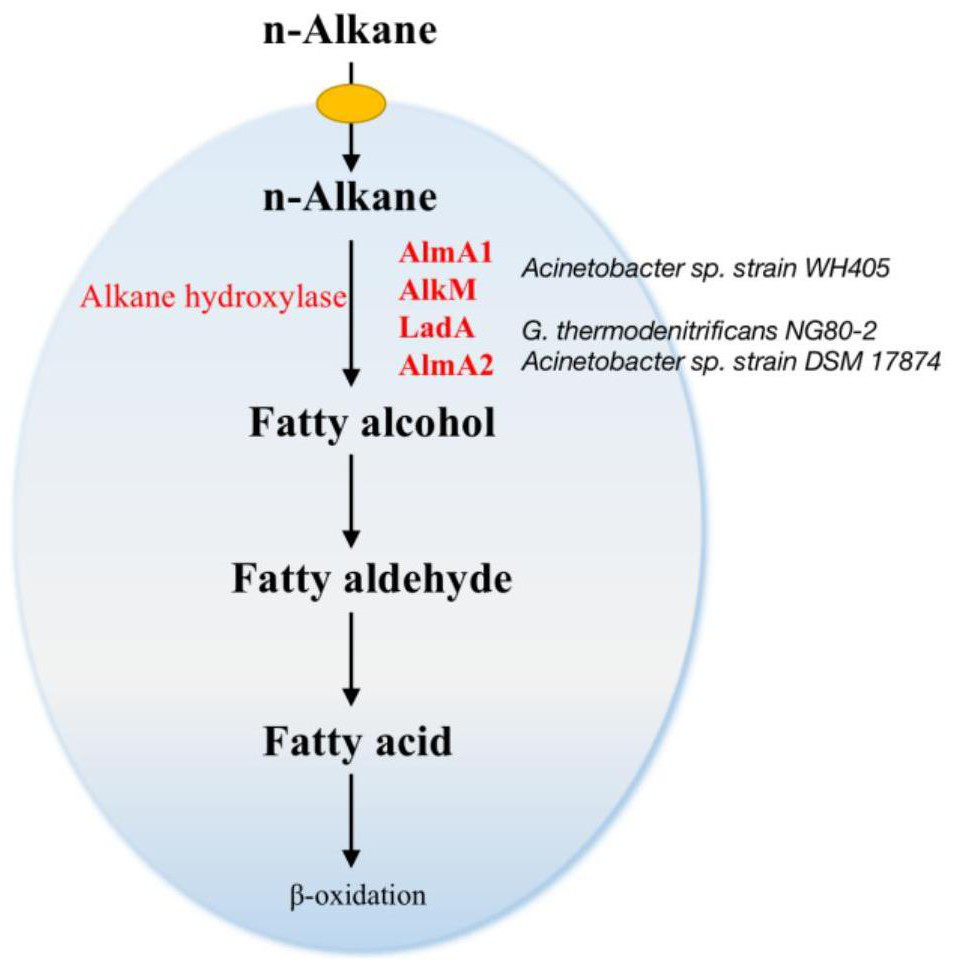Yeast strain for degrading long-chain alkane and application thereof
A technology of alkanes and bacterial strains, applied in the field of microorganisms, can solve the problems of low degradation efficiency of long-chain alkanes and difficulty in meeting the requirements of alkane degradation, and achieve the effect of improving the efficiency of alkane degradation
- Summary
- Abstract
- Description
- Claims
- Application Information
AI Technical Summary
Problems solved by technology
Method used
Image
Examples
Embodiment 1
[0083] Example 1 Construction of a lipolytic chassis for strengthening the alkane degradation pathway
[0084] The present invention selects Yarrowia lipolytica, and exogenously expresses AlmA1 and AlkM derived from Acinetobacter sp. ADP1, LadA alkane hydroxylase gene derived from Geobacillus thermodenitrificans NG80-2, and AlmA2 derived from Acinetobacter sp. M-1, respectively. To achieve efficient degradation of long-chain alkanes. Degradation of long-chain alkanes by Yarrowia lipolytica figure 1 shown.
[0085] 1. Screening of alkane hydroxylases
[0086] In this study, Yarrowia lipolytica ATCC 201249 was selected as the starting strain, and the codon-optimized alkane hydroxylase (AlmA1, AlkM, LadA and AlmA2) genes of Yarrowia lipolytica were integrated into the PUC57 vector. BsaI restriction site. After digestion with BsaI, the digestion system was subjected to gel electrophoresis, and agarose gel recovery kit was used for fragment recovery to obtain linear fragments A...
Embodiment 2
[0101] Example 2 Construction of a lipolytic chassis for strengthening the alkane transport pathway
[0102] 1. Overexpression of alkane transporters
[0103] The current research on the mechanism of alkane degradation is not only the first step of the hydroxylation process of alkanes entering cells, but also focuses on the study of genes encoding alkane transporters. Protein-mediated transport of small molecules across the cytoplasmic membrane is important for the import and export of hydrophobic or lipid compounds. Although membrane transporters are involved in one-third of remodeled metabolic networks in yeast, they are still widely ignored. In Yarrowia lipolytica, the alkane transporter ABC1, similar to the yeast pleiotropic drug resistance transporter PDR5, was identified as required for alkane uptake.
[0104] Therefore, we overexpressed lipolytic yeast endogenous alkane transporter (ABC1) in wild-type lipolytic yeast and engineered yeast YAH06, hoping to further impro...
PUM
 Login to View More
Login to View More Abstract
Description
Claims
Application Information
 Login to View More
Login to View More - Generate Ideas
- Intellectual Property
- Life Sciences
- Materials
- Tech Scout
- Unparalleled Data Quality
- Higher Quality Content
- 60% Fewer Hallucinations
Browse by: Latest US Patents, China's latest patents, Technical Efficacy Thesaurus, Application Domain, Technology Topic, Popular Technical Reports.
© 2025 PatSnap. All rights reserved.Legal|Privacy policy|Modern Slavery Act Transparency Statement|Sitemap|About US| Contact US: help@patsnap.com



